The fresco by Giambattista Tiepolo (Venice, 1696 - Madrid, 1770) and the frieze by Niccolò Bambini (Venice, 1651 - 1736) decorating the ceiling of the main floor hall of Palazzo Sandi in Venice have been restored. The work is part of the initiatives for the 75th anniversary of the founding of theVenice Association of Builders, which has its headquarters in Palazzo Sandi.
The restoration was carried out in two phases. The first one was dedicated to the frieze that develops under the fresco, while the second one was dedicated to the recovery of the fresco with the aim of intervening by restoring the work to its original quality. In fact, the fresco has been the subject of several restoration interventions in the past, conducted with different techniques and technologies, which have contributed to changing its original appearance and colors. The current restoration, on the other hand, is characterized precisely by the desire to restore to the painting the chromatic characteristics proper to Tiepolo. This approach has thus made it possible to bring back to view details that had been covered and erased. These include a figurine of a figure in 18th-century clothing, probably the patron.
The history of the fresco takes us back to 1724, when Count Tommaso Sandi, heir to an important family of lawyers and recent members of the Venetian patriciate, on the occasion of the wedding of his son Vettor, commissioned Giambattista Tiepolo himself to create a decorative cycle of paintings with subjects that were to celebrate the virtues of the family, to decorate the piano nobile of his Venetian residence. In addition to the fresco, the hall in fact housed a number of canvases, three by Tiepolo himself and two by Bambini, that related to the ceiling fresco. These canvases are now kept in the breakfast room of the Hilton Hotel in Rome. ANCE’s hope is that one day the complete room’s setting can be recreated. In any case, to give an idea of what the hall looked like in its original configuration, the association has developed a virtual and interactive reconstruction of the set of works that graced the hall.
“For us building contractors,” says President Giovanni Salmistrari, "meeting periodically in the Council Chamber and looking up at the ceiling has always been a blessing and a privilege. Having an artistic heritage such as the two works The Triumph of Eloquence by Tiepolo and Primitive Humanity by Bambini is also a responsibility. Preserving it and ensuring its aesthetic and technical qualities has always been our commitment. Thus, on the occasion of an anniversary such as the 75th since the founding of ANCE Venice, the Board felt it was its duty to invest in restoring to its original beauty a work that is perhaps less well known but equally valuable as our fresco. Those who have always loved and worked paying great attention to details and to the quality of works that, in addition to being functional, must also respond to aesthetic canons, cannot but be extremely proud to bring back to life and make available to all a heritage such as the one we guard."
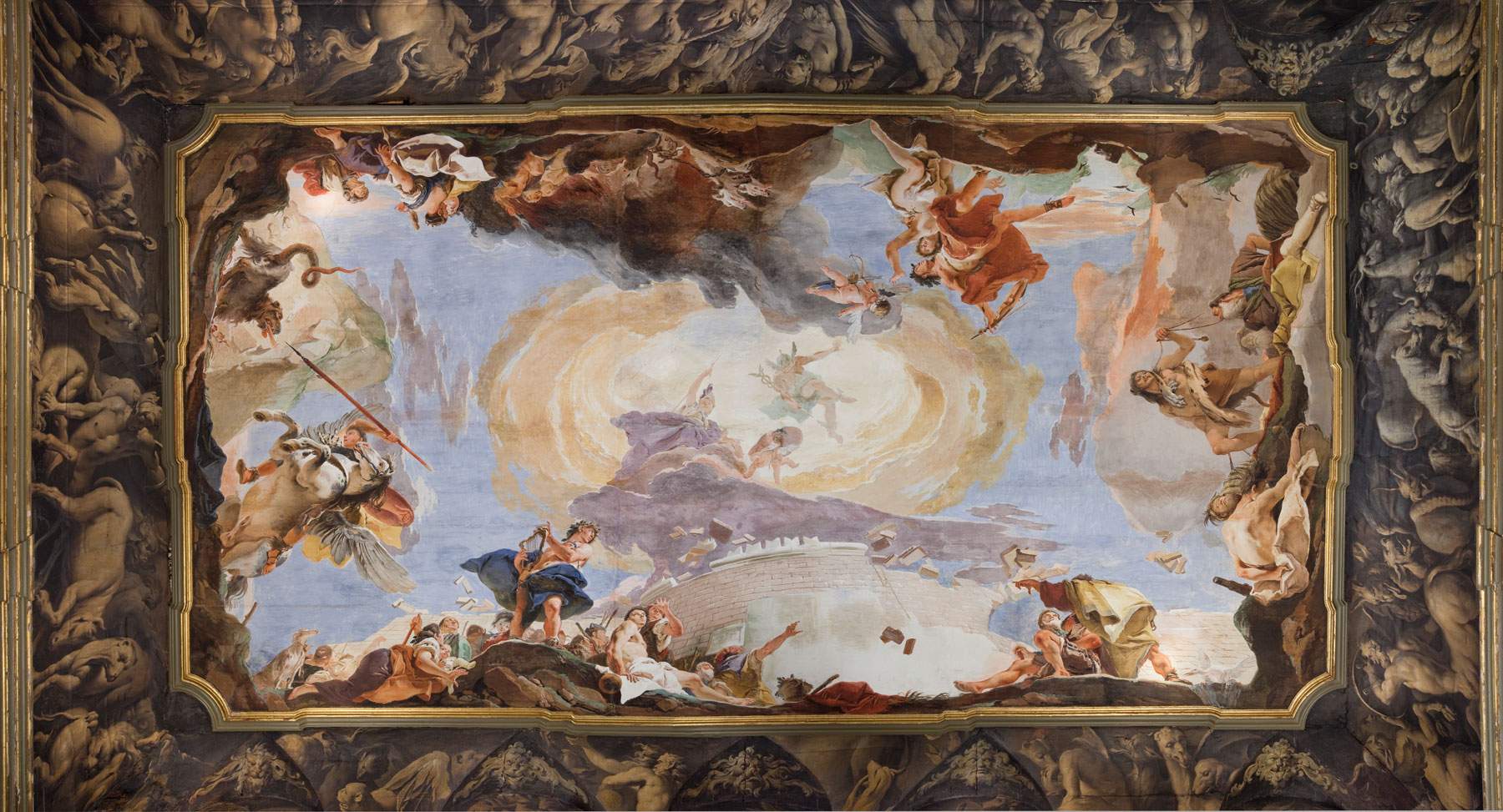
 The salon on the
The salon on the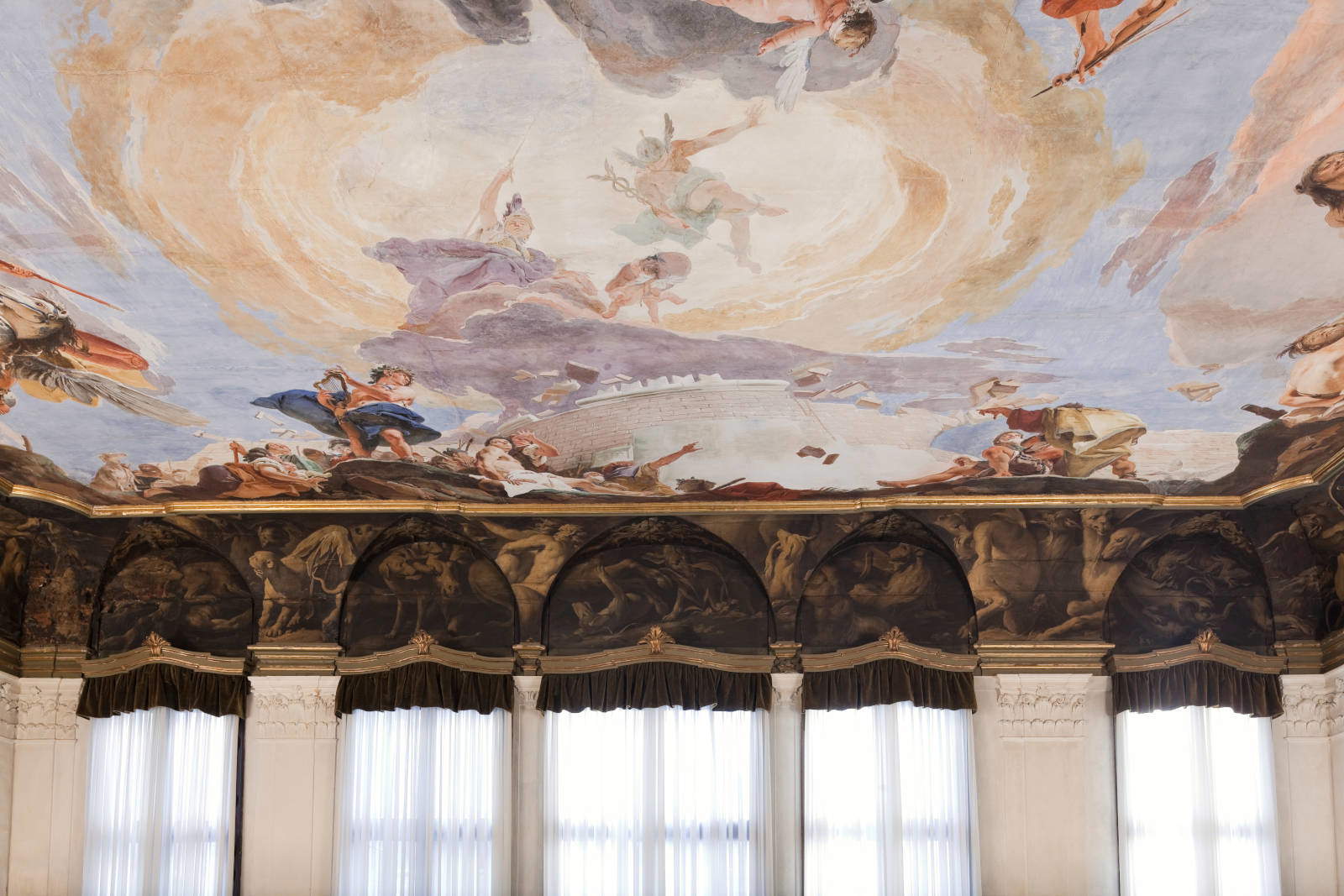 The salon of the piano nobile of Palazzo
The salon of the piano nobile of Palazzo The salon of the piano nobile of Palazzo
The salon of the piano nobile of PalazzoWork on Tiepolo’s fresco was carried out by the restoration and conservation firm Lithos of Venice. At first analysis, the condition of the Triumph of Eloquence was fair: small lesions, cracks, incongruous plastering, and minor interventions, in some cases completely unnecessary, carried out with inappropriate materials. The conservation intervention started after a photo-plan of the affected area and monitoring of the entire surface of the painting using Wood’s lamp was carried out. This technique was used in the phase of ascertaining the state of degradation of the work and, more specifically, in verifying the existence and extent of non-original parts of the pictorial fabric. The results of the monitoring were graphed by mapping the responses of the surfaces to the ultraviolet light beam. During monitoring, sample detail photos of the entire surface were taken and fluorescence mapping was conducted.
The restoration began with a preliminary dry cleaning of the inconsistent surface deposits, extended to the entire surface, using soft brushes. Next, pre-consolidation of the paint film was carried out in areas with instability problems. Following manual beating of the surfaces, areas of plaster detached from the support were identified. Injections of premixed fluid mortar with low specific gravity and free of salts were then performed. Grouts deemed incongruous, as degraded or made with unsuitable materials, were removed in some cases and lowered in others. The operation was first carried out by brush application of acetone with juxtaposition of Japanese paper to remove synthetic-based repainting, followed by compressing with demineralized water to soften the grout mixture. Finally, mechanical removal was carried out.
After a positive opinion from the Superintendent’s Office, the repainting identified during the analysis phase was removed, using compresses of ammonium carbonate in 10% solution given by brush with juxtaposition of Japanese paper. The surface was then rinsed with demineralized water and sponges. The process was repeated until the repainting was completely removed. The previously removed fillings were supplemented or rebuilt where necessary (at lesions, gaps, etc.) with mortar suitable in grain size and color with the original materials. Finally, in order to ensure homogeneity in the reading of the surfaces, reintegration (by glazing with watercolor) of falls of the paint film or abrasions and tone reintegration with dashed or dotted watercolor background of the altered lacunae and stuccoes was carried out.
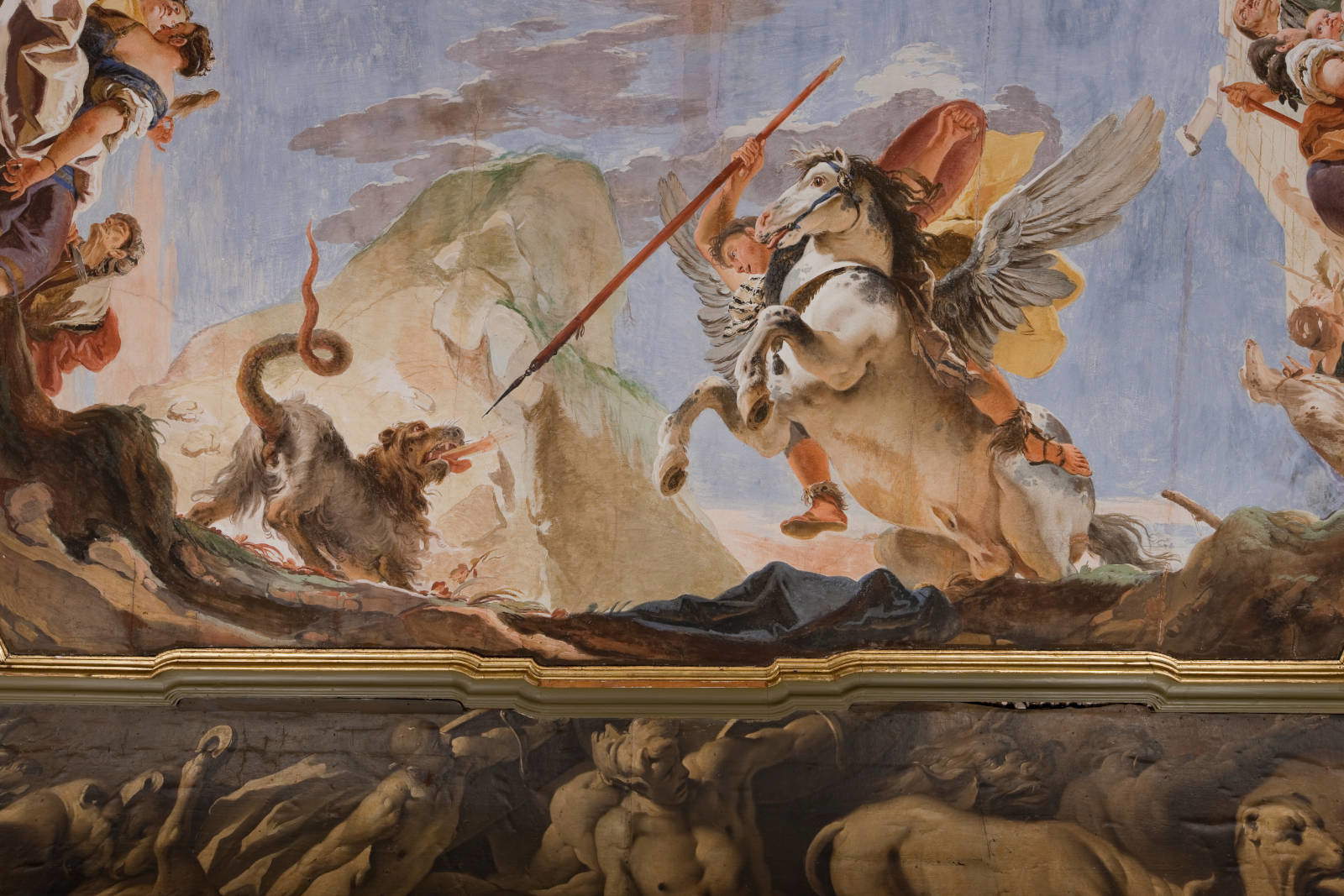
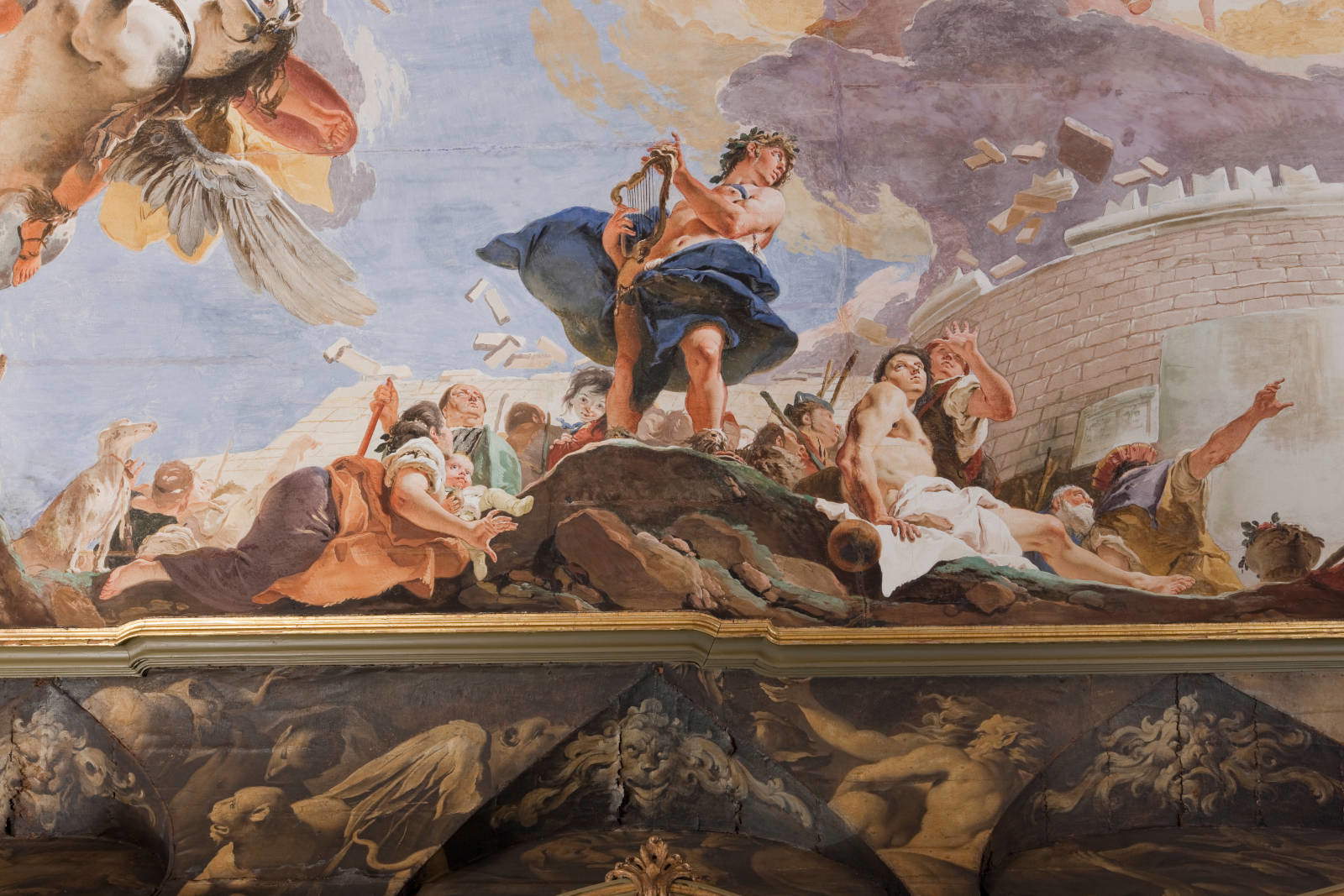 Detail of the
Detail of the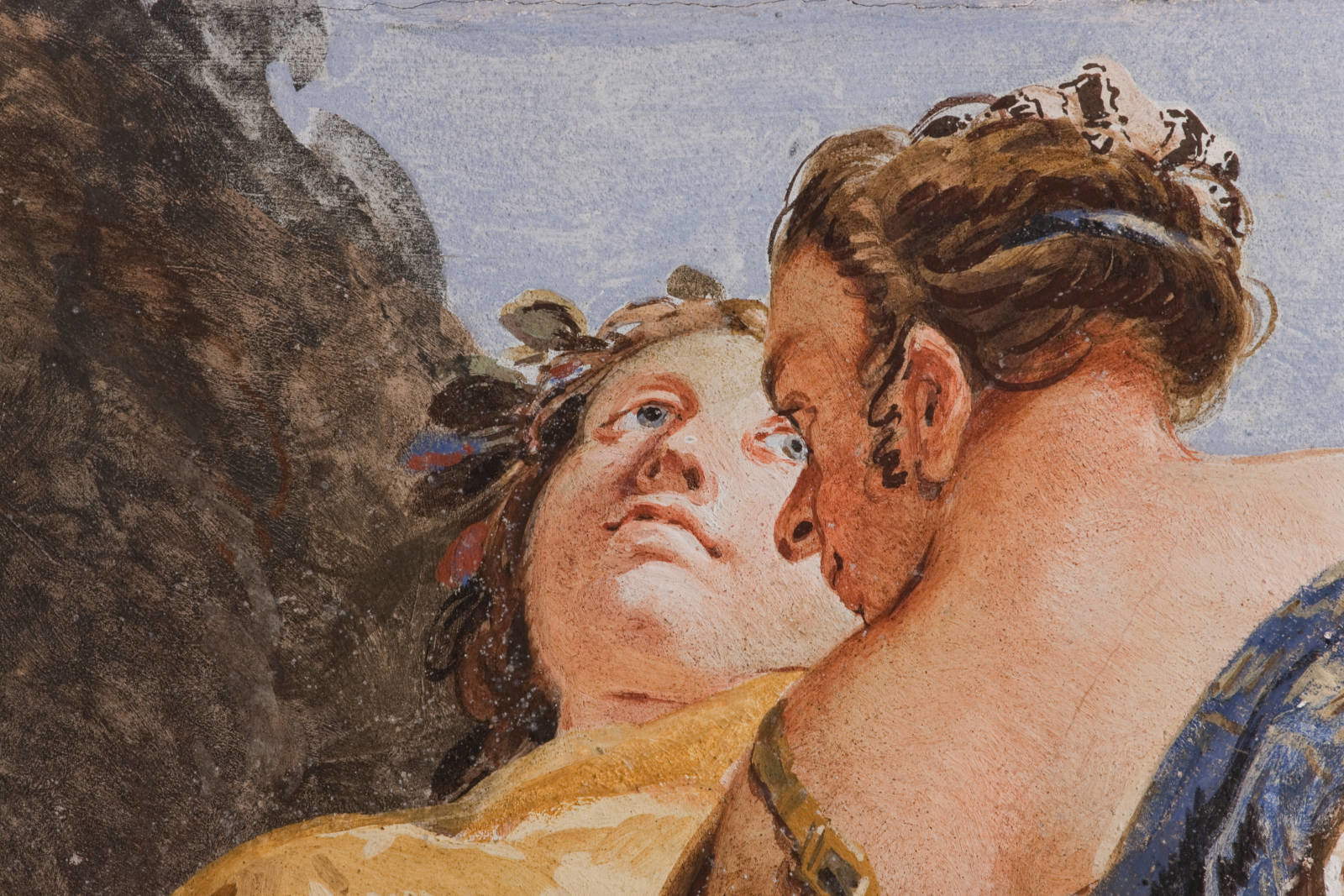 Detail of the
Detail of the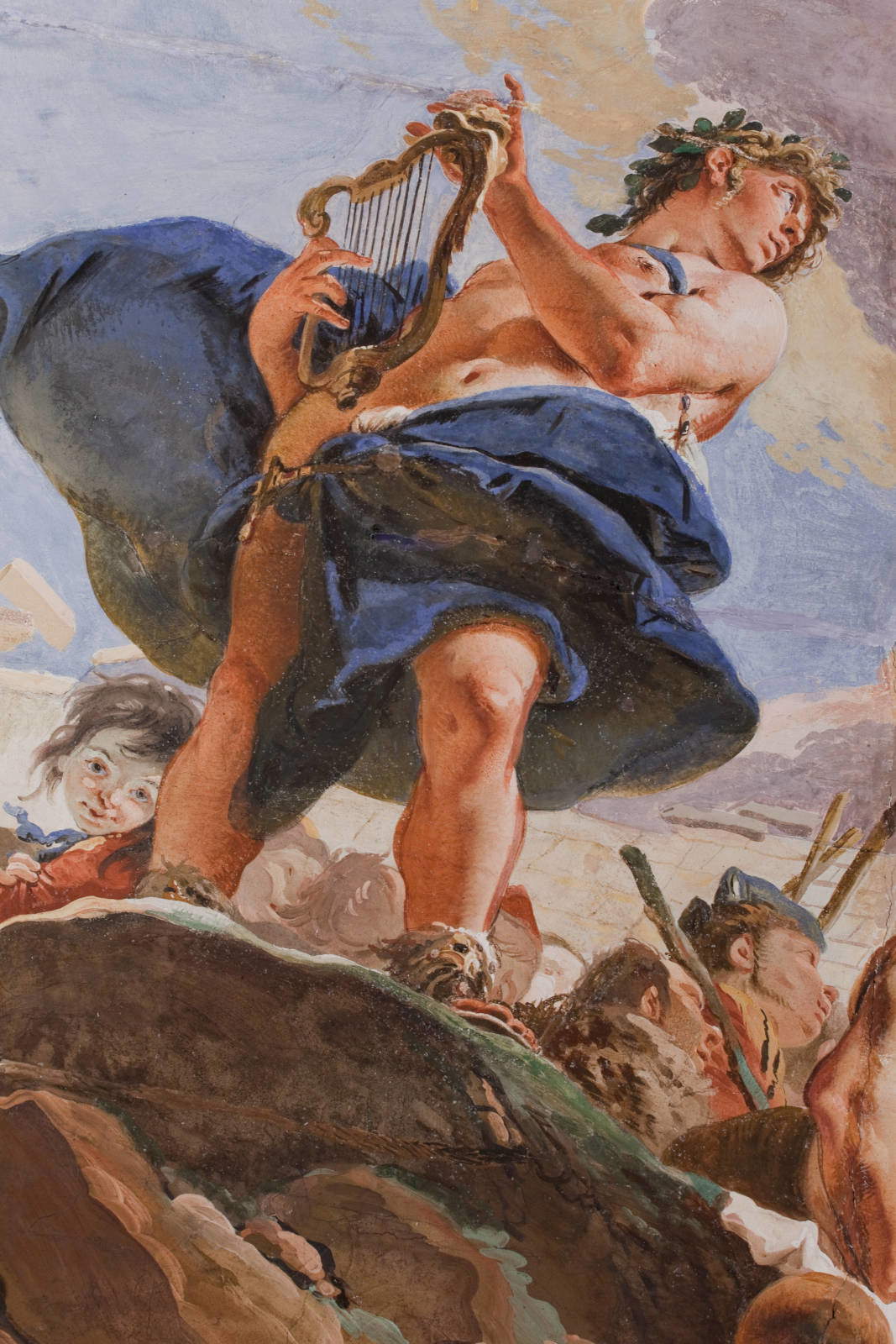 Detail of the
Detail of theThe project to restore Bambini’s frieze and its wooden frame was handled by architect Federica Restiani, scientific manager of the Veneto Institute for Cultural Heritage and director of the work, together with restorer Jean Pierre Zocca and Monica Rovea, Annalisa Nardin and Anna Zulian. “The pictorial decoration of the salon on the piano nobile of Palazzo Sandi,” says Restiani, “has been studied so far mainly for the presence of the first fresco with a secular subject by the young Giambattista Tiepolo, while less attention has been paid to the work attributed to Bambini, both from the stylistic point of view and in terms of execution technique. However, to fully understand the reasons and significance of the entire decorative scheme, which represents a unicum in the panorama of 18th-century Venetian painting, the works of the two artists (and the aspirations of the patrons) cannot be separated. Indeed, the iconographic program, although articulated on different surfaces, is unified and unfolds through the pictorial narrative of two opposing but mutually connected concepts: the main subject, in the central plate of the ceiling, Triumph of Eloquence, and in contrast, immediately below, the Primitive Humanity (or Allegory of Lasciviousness) confined within a long frieze painted in monochrome that runs uninterruptedly on the four walls of the room, where, within stucco reliefs, three other canvases were framed as a corollary to the allegorical narrative. We know that work on the modernization of the palace was initiated by Tomaso Sandi in conjunction with the wedding of his son Vettor, 1724, so it is quite reasonable to identify in the conformation of the architectural frame of the room and in the decorative program a unique and organic project, strongly linked to the aspirations of the patron: Indeed, unable to flaunt a nobility of ancient origins, Vettor’s father decided to celebrate his own lineage through the exaltation of the virtues, wisdom and eloquence, associated with the practice of his profession, lawyering. The Sandi thus celebrate ’the civilization of the word,’ regulated by the exercise of virtue, which guides man’s intellect and floods the entire room with light (Tiepolo), relegating to the margins, groping in the dark, a primitive world of monstrosities, vice and suffering (Bambini).”
The monochrome decorative band contiguous to the ceiling runs along the four walls of the main hall, for a total length of 33 linear meters and a height of 1.50 meters with a total of 50 square meters of painted surface. Iconographically, the mythological subject ofPrimitive Mankind depicts the primordial existence in which primitive men ignored the use of speech, were wandering, and had no clothes: semi-human beings such as centaurs, fauns, satyrs, and pegasuses, struggling with each other. In assonance with human cruelty, the fierce struggle between bulls, lions, unicorns, hippogriffs and other animals is depicted. The allegorical tale, in its decorative rhythmic development, is sustained by strong tension and tight dynamism. The tendentially monochrome tone field recalls the darkness in which primitive humanity lived in contrast to the theme of the Triumph of Eloquence depicted on the ceiling, elevated in light.
The frieze is made using the marouflage technique. This term, derived from the name of the animal glue used(marouflé), denotes an oil painting made not directly on the architectural surface but through the mediation of a canvas without a frame and fixed by means of glue and nails. The procedure was already known in Italy as early as the 15th century, but it was not codified with the term marouflage until the 17th and 18th centuries in France. The frieze was in a rather critical state of preservation, conditioned by microclimatic variations in the salon: it is possible to assume that for several centuries the internal environmental interaction, of the salon of Palazzo Sandi (having no heating for 250 years), was conditioned by natural seasonal variations in assonance with the humid climate of Venice. In the middle of the last century, radiators were installed in the building and in the main floor salon, which made a major change in the climatic variability of the room.p
The other decisive cause of deterioration is to be found in the different micro-tensions between the textile support of the painting and the wooden structure on which it is anchored. In the succession of these continuous opposing tensions on the painting, in different areas and for long stretches, tears, lifting of the textile support, cracking of the preparatory layer and the pictorial film, and, as a result, several falls of the pictorial film were formed. In other places, the canvas has detached from the scaffold, probably due to weakness at the origin of the bonding, consequently forming bubbles, undulations and wrinkles. In addition, the work, like Tiepolo’s, has undergone numerous structural interventions over the years that were not always well executed.
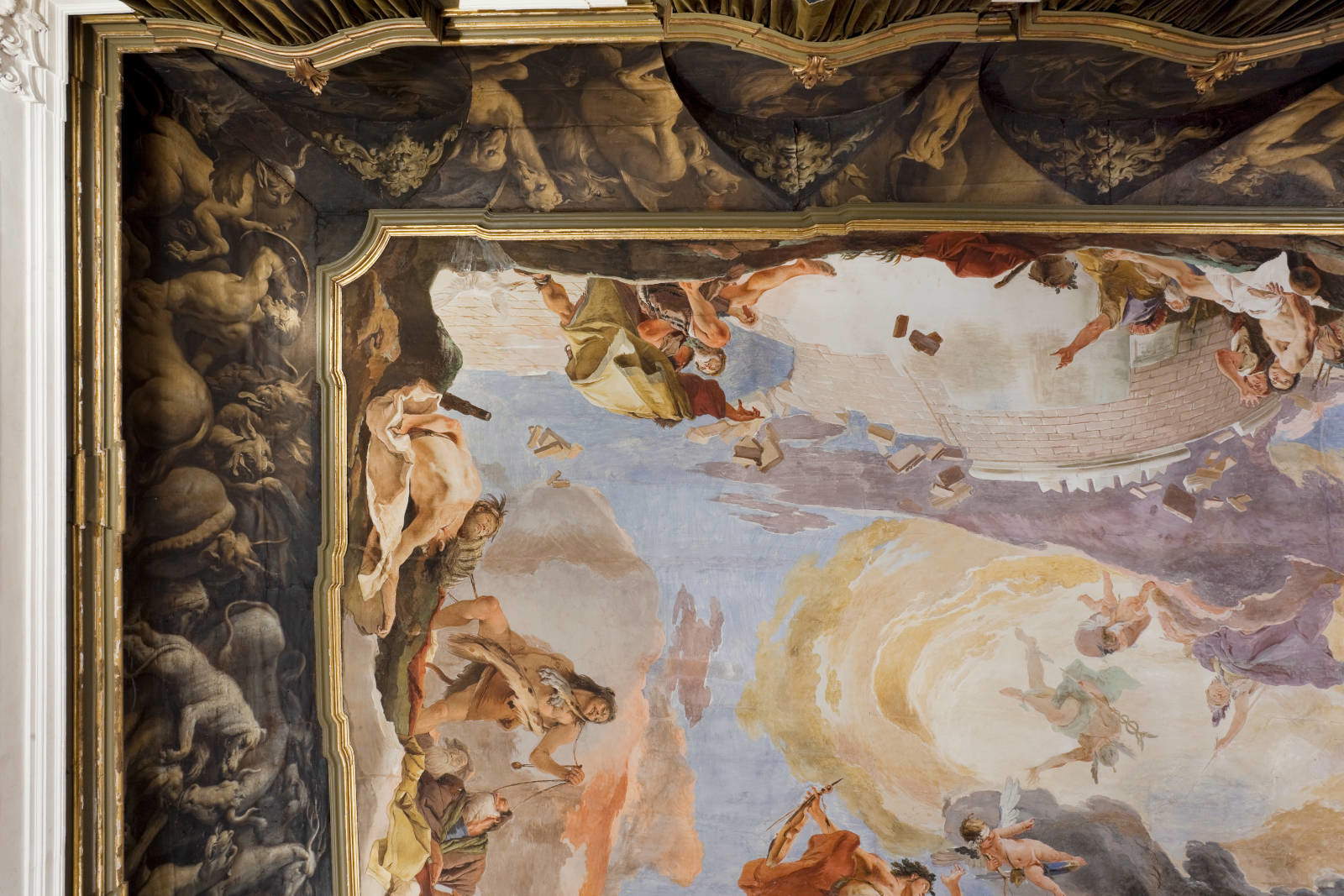
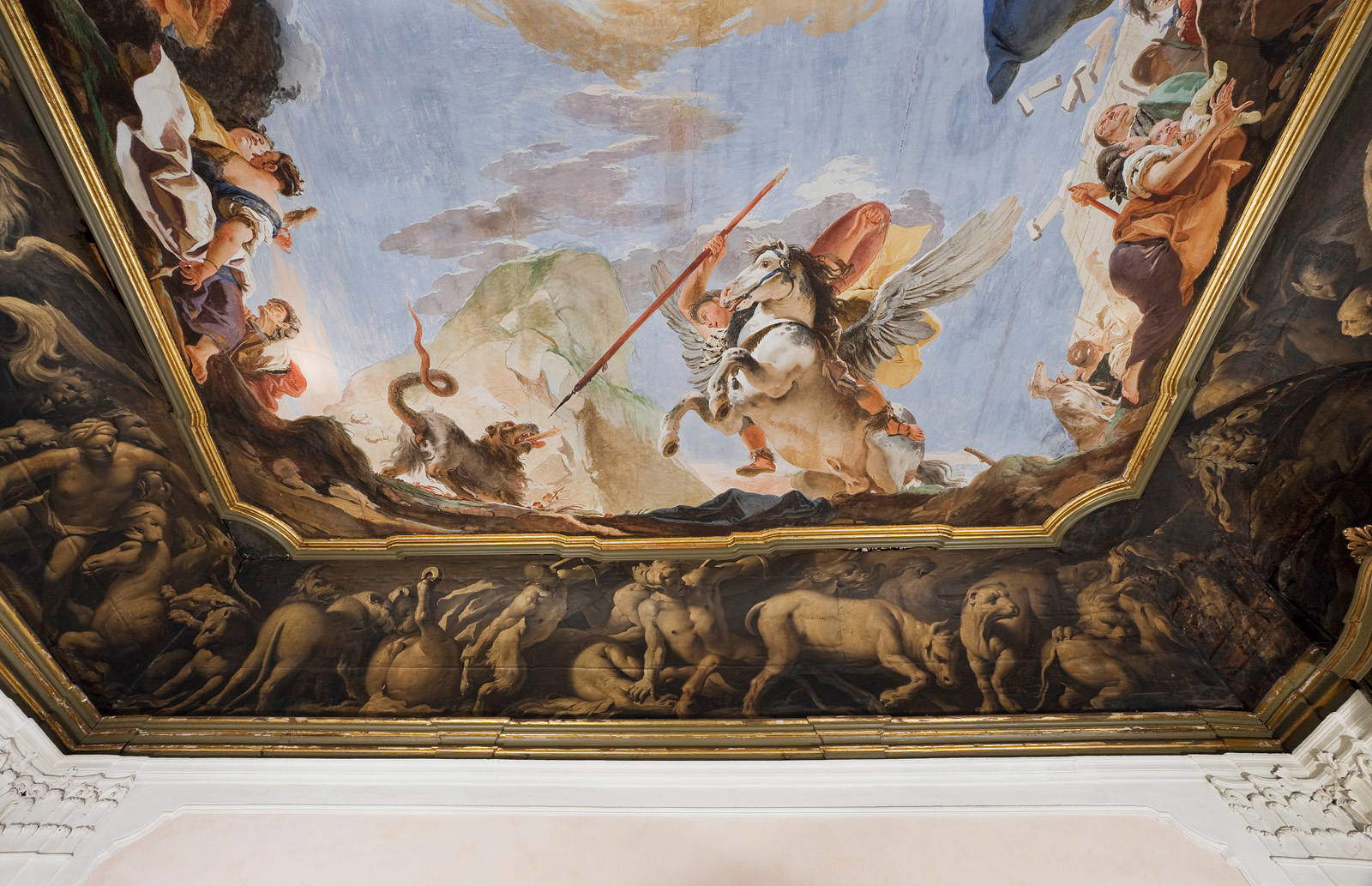 Detail of the frieze
Detail of the friezeAfter the basic diagnostic and microclimatic surveys and some cleaning tests, we moved on to the restoration work. The first operational phase was aimed at the re-adhesion of the detachments of the textile support, the painting, to the wooden ribbed supporting scaffold, and the stopping of the raised pictorial film. The re-adhesion operation was conducted selectively, advancing by sectors of one square meter along each side of the frieze surface and analyzing the situation under grazing light. The detached and lifted canvas segments, mostly torn, were fixed. Canvas ripples and bubbles distributed on the painting’s surfaces that did not present problems of color stability were not treated because they were considered stabilized, historicized deformations and not at risk for the good conservation of the work. After some trials, the best result was obtained by the “modified Roman colletta,” named “colletta Doria” after the author who formulated it. To thicken the “colletta Doria,” after experimenting with some materials, flour, which is generally used in paste glue for lining, was preferred, albeit in a small percentage. To give the hue in accordance with the original preparation of the painting, two pigments were added in equal proportions in the collagen mixture: burnt sienna and burnt shadow earth, until a gelatinous consistency was achieved. Later, to restore an imminent risk of collapse, it was necessary to remove some rubble from the back of the corner scaffold, and some segments of the painting were disassembled from the supporting structure.
The animal glue-based mashers, spread on the pictorial surface in the past, had deteriorated over time, turning the original color into a brownish-yellow tone and preventing a proper reading of the monochromatic work with light and dark modulations of whites, blacks and grays. To remove the degrading layer and recover the original chromatics, a chelating solution based on citric acid and Tea . The solution applied by brush, on Japanese paper interposed on the surface, allowed the protein glue to be solubilized and absorbed into the paper itself. Then, by means of a sponge slightly moistened with warm water, the residues were removed from the surface.
After some minor but important pictorial reintegration and plastering, the final painting was done. Prior to spray painting, it was necessary to protect all surfaces around the pictorial frieze so that the misting would not damage the works around it. Both the ceiling frescoed by Tiepolo and the gilded frame outlining the painting were hermetically covered with lightweight nylon sheeting. The final painting was done by mixing two paints. The resulting mixture equalized and improved the optical characteristics of the pictorial surface. Kept lukewarm, the varnish was sprayed by nebulization using a gun and compressor. This protective finish created protection from ultraviolet radiation, which is detrimental to the preservation of the painting’s colors.
Conservation work was then conducted on the wooden frames, as the gilded frames around the frieze were in a poor state of preservation. Again, after diagnostic analysis, conservation work was carried out. Before starting, a thorough dusting of the substantial surface deposits was carried out along the two cornices with a soft brush and vacuum cleaner, paying attention to the unsafe parts. Where dusting was not possible, due to unstable uplifts, localized prefixing of the flakes was carried out. This difficult operation was carried out, gradually and selectively, respecting the delicate gilded and polychrome surfaces. Once the cleaning was completed, an initial brush painting of the gilded surfaces was carried out. Then, after a few tests, the gaps were filled in, gradually, bringing them to the same level as the original decoration. Finally, the stucco surface was treated with light sanding using very fine sandpaper and finishing with a scalpel. Some parts of lost wooden moldings along the edges of the frames were reconstructed with appropriately shaped wooden inserts. After careful consideration of the method, it was determined that, given the extensive presence of gaps, the retouching had to create continuity, but not to the same tone as the gilding. The methods of execution of the retouching: pictorial integration by hatching with watercolors, in imitation of the bole; protection of the hatching with varnish applied with a brush; application of a veil of wax with a soft cloth; gilding wax finish based on metallic pigments in imitation of classical gold, leaving a glimpse of the red bole of the lacuna, i.e., reintegration by watercolor and final polishing with woolen cloth.
 |
| Venice, Tiepolo fresco in the salon of Palazzo Sandi restored |
Warning: the translation into English of the original Italian article was created using automatic tools. We undertake to review all articles, but we do not guarantee the total absence of inaccuracies in the translation due to the program. You can find the original by clicking on the ITA button. If you find any mistake,please contact us.